All?gre Claude J. Isotope Geology
Подождите немного. Документ загружается.


¼
C
m
1
P
ð1Þ
C
m
2
P
ð2Þ
ln ¼ ln
P
m
1
ln
P
m
2
¼ D
m
gz
RT
:
From the approximation formulae we have already met:
Dd
1000
D
m
gz
RT
with
g
¼10 m s
1
,
T
¼200 K, for
z
¼10 m, and
R
¼2.
This gives d ¼0.25 for nitrogen and d ¼1.1 for argon. Once again, extremely precise
methods for measuring isotope ratios had to be developed.
Greenland and Antarctica records compared and the complexityof cli mat ic
determi nants
Although stu dies of Greenland ice cores pre-date d thatoftheVos tokcoreby far, itwasonly
after theVostokcore had been deciphered thatthe signi¢cation ofthe Greenlan d cores was
fully understoodbycontrast(Figure 7.39). It wasob servedthattherecordoftheoxygen and
hydrogen isotopes at Vostok was much si mpler than in Gre enland and that the
Mil ankovitch cycleswere clearly recorded.
Things are more complex in Greenland because sudden climatic events are supe rim-
posed on the Milankovitch cycles.The ¢rst well-documented event is a recurrent cold per-
iod at the time of transition from the last ic e age to the Holocene repor ted by Dan sgaard’s
team in 1989.While some 12 800 years ago a climate comparable to that of today set in, it
was i nterrupted 11 000 years ago by a cold episode that was to last about 1000 years and
which isknownas theYounger Dryas.This event wasfoundsomeyearsl ater inthe sedimen-
tary recordofthe NorthAtlantic.
Generalizing on this discovery, Dansgaard used oxygen isotopes to show thatthe glacial
period was interrup ted by war m periods that began su dden ly and ended more gradually.
These events, ofthe orderofa fewthousandyears, correspondto a 4^5ø changein the
18
O
value of the i ce and so to a temperaturevariation ofabout 7 8C. Dansgaard’s team reported
24 instances ofthis type of D^O episod e, as theyare called (D is for Dansgaard and O is for
Oeschger), between12 00 0 and110 000 years ago.Theyhavebeen detectedinthe sedimentary
records of the North Atlantic and as far south as the intertropical zone. Cross-referencing
between sedimentary cores and polar ice cores has proved so instructive thatboth types of
recordcontinue tobeusedtoanalyzeoneand thesame event.
A second seri es of events was read this time from the sedimentary records. These were
brief events characteri zed by the discharge of glaciers as far as the Azores.There are 34 of
these H events (se e Heinrich,1988) during the last glacial period and nothing comparable
has been identi¢ed in the ice of Greenland.The relationship between D^O and H events is
unclear, but what is clear is thattheyarenotidentical happenings.
What compounds the mystery is that these brief events are recorded very faintly in
Antarctica, with atimelag.Therearetherefore oneor more mechanismsgoverningclimate
419 Paleoclimatology
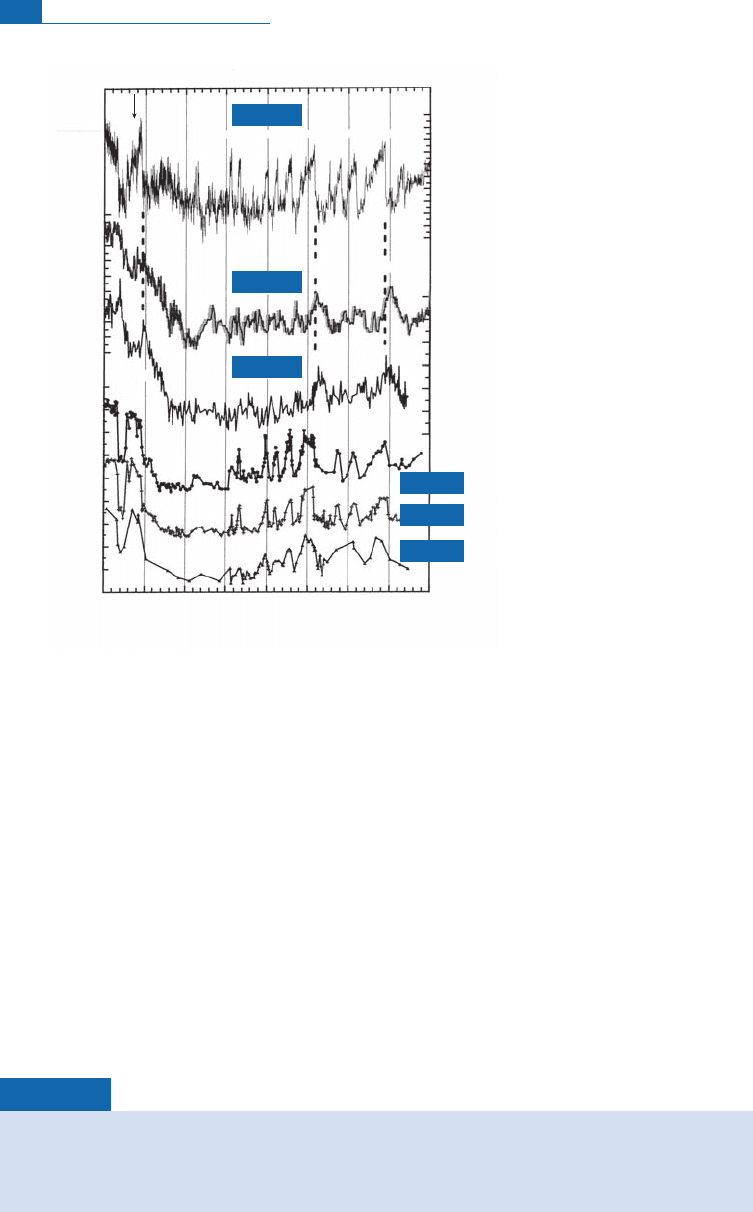
thataresuperi mposedonthe Milankovitchcycles.Whyareth ese eventsmorereadilydetect-
able inthe n orthern hemisphere? One ofthebig di¡erencesbetween thetwohemispheres is
the asymmetric al distr ibution of landmasses and oceans (Figure 7.4 0 ).This is probably an
important factor, but how does it operate? We don’t know. This qualitative asymmetry is
compoundedbyafurtherasymmetry. Itseemsthatthetransitionsbetweenglacialandinter-
glacial periods occur 400^500 years earlier in the Antarctic. Once again, there is as yet no
clearandde¢nite explanation for this.
Exercise
When the d
18
O values of foraminiferan shells are analyzed for glacial and interglacial periods,
variations are of 1.5ø for cores from the intertropical zone but of 3ø for cores from the
temperate zones. How can you account for this phenomenon?
0
200
400
–440
–460
–480
600
800
–42
–40
–38
–36
–34
ACR
A1
2
1
MWP Ia
34 56 7 8 9 1110 12 13
A2
Age (BC)
CH
4
(ppb by vol) δ
18
O (‰)
δD (‰)
–34
–36
–38
–40
–40
–44
δ
18
O (‰)
10 000 20 000 30 000 40 000 50 000
VOSTOK
BYRD
GRIP
VOSTOK
BYRD
GRIP
Figure 7.39 Comparison of records from the Antarctic and Greenland. Vostok and Byrd are two stations
in the Antarctic; Grip is a borehole in Greenland. Notice that the two CH
4
(methane) peaks are quite
comparable in both hemispheres, which is evidence that chemically the atmosphere is broadly
homogeneous. By contrast, the d
18
O (and dD) records are very different. Greenland is the site of
many sudden climatic events that have been numbered, which events are not seen in Antarctica.
After Petit
et
a
l
.(1999).
420 Stable isotope geochemistry
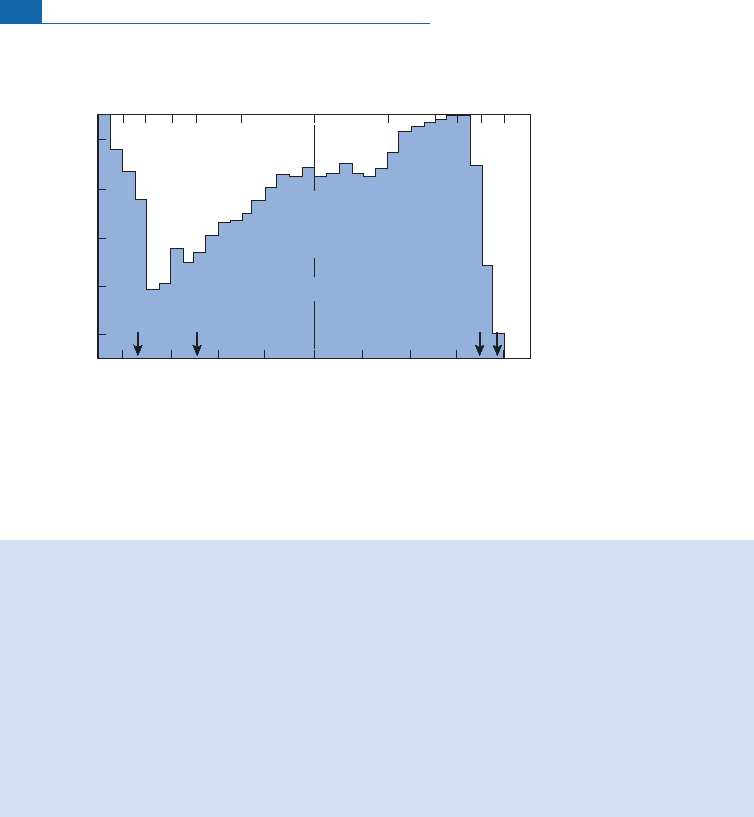
Answer
Temperature variations between glacial and interglacial periods are very large at the poles,
very low in the intertropical zone, and intermediate in the temperate zones. The variation of
1.5ø for the intertropical zone is caused by the melting of ice. It must therefore be considered
that the additional variation of 1.5ø of the temperate zones is due to a local temperature
effect. Applying the Urey–Epstein formula of the carbonate thermometer
T
8C
¼ 16:34:3ðdÞ=0:13ðdÞ
2
gives
T
4.3 d. This corresponds to 5–6 8C, the type of temperature difference one would
expect in the temperate zone between a glacial and interglacial period.
Veryrecently, theice recordhasbeen extendedto 700 000 years thanks tothe core drilled
byan international consortium in Antarctic a atthe EPICA site. As Figure 7.41 shows, this
facilitates comparison between sedimentary and ice records. New data can be expected
shortly.
7.8 The combined use of stable isotopes and radiogenic
isotopes and the construction of a global geodynamic
system
Climate is acomplexphenomenonwith multipleparameters.Temperature, ofcourse, is a car-
dinal parameter, but the distribution of rainfall, vegetation, mountain glaciers, and winds
are essential factorstoo.Oxygenanddeuteriumisotopesprovidevitalinfor mationabouttem-
peratures and the volume of the polar ice caps. The
13
C/
12
C isotopes are more di⁄cult to
Percent per 5° of latitude
Latitude
N
S
Surface (%)
70
80° 80°
90° 90°
50
30
10
90
98
8694 50 0 50 75 86 94 98 10075100
60° 60°40° 40°20° 20°0°
Ocean : 361 x 10
9
km
2
Continent:
149
x 10
6
km
2
Equator
Figure 7.40 Distribution of landmasses and continents by latitude. The difference between northern
and southern hemispheres is clearly visible.
421 The Construction of a global geodynamic system
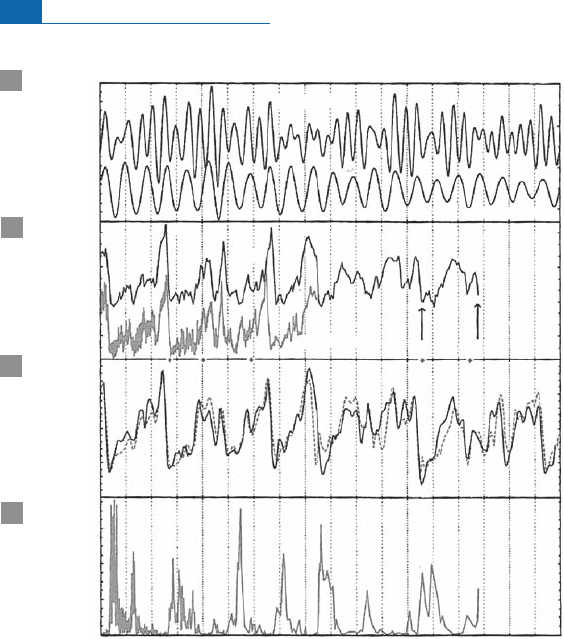
interpretbutyieldusefulpointers,forexample,aboutthetypeofvegetation(C
3
/C
4
plants)and
its extent. But such information, which should in principle enable us to construct a biogeo-
ch emicalpicture, isstillverydi⁄cultto decipherand hasbeenoversimpli¢edinthepast.
The use of long-lived radiogenic isotopes has a similar objective, namely to determine
how climatic £uctuations are re£ected in the planet’s erosional system. Erosion is a funda-
mental sur face process. It is what changes volcanoes or mountain ranges into plains and
peneplains.The end products oferosion are of two types. Some chemical elements are dis-
solved as simple or co mplex ions, while others remain in the solid state. The form er are
transported in solution, the latter as particles.Whichever state they are in, they are carried
by rivers down to the oceans where they form sea water in one case an d sediments i n the
other.The radiogenic isotope ratios are preserved throughout these erosion and transport
p rocesses.They are th en mixed in the ocean, either as solutions i n sea water or as particles
in sediments.The erosion sites have characteristic radiogenic isotope signatureswhich dis-
tinguisholdlandmasses,youngcontinents,andvolcanicproductsofmantleorigin.Theiso-
topic compositions ofthe m ixture thatmakesup seawater thusre£ectth e proportionofthe
variou s sources involved inthe e rosionprocesses.
65° N July
75 S /year
11.35.5
EPICA
Vostok
16.2 18.4
0 200 400 600
Age (ka)
800
Insolation (75°S) (W m
–2
)
Insolation (75
°
S) (W m
-2
)
Dust in mass (μg kg
-1
)
δD (‰)δ
18
O-marine (‰)
120
185
190
480
440
400
-380
-410
-440
-470
-3.0
3.0
1.200
800
400
0
-1.5
1.5
0
a
b
c
d
Figure 7.41 Comparisons of (a) insolation and sedimentary (c) and glacial (b, d) records at the EPICA site.
After the EPICA Community (2004).
422 Stable isotope geochemistry

7.8.1 Strontium in the ocean
A ¢rst example is the
87
Sr/
86
Sr isotopic composition ofpresent-dayseawater.The
87
Sr/
86
Sr
ratio is 0.70917 and is identical whichever ocean is considered.Where does the Sr c ome
from? Obviouslyfromthe erosion oflandmassesandsubaerialorsubmarinevolcanic activ-
ity. Measurementofthe isotopic composition of Srdissolved in riversyields a meanvalue of
0.712 0.001. The mean isotopic composition of the various volcanic sources (mid-ocean
ridges, islandvolcanoes, and subduction zones) lies between 0.7030 and 0.7035 (depending
on the relative importance attribute d to the various sources). From the mass balance
equation:
87
Sr
86
Sr
sea water
¼
87
Sr
86
Sr
continental rivers
x þ
87
Sr
86
Sr
volcanic inpu t
ð1 xÞ:
The fraction from continental rivers corresponds to 66% 2% of the Sr in sea water.
(Notice this fraction x re£ects the mass of ch emically eroded continent modulated by the
correspondingabsolute concentration of Sr.)
x ¼
_
m
c
C
c
_
m
c
C
c
þ
_
m
v
C
v
where
_
m
c
is the mass of continent eroded chemically per unit time,
_
m
v
is the mass ofvolca-
noes eroded chemi cally per unit time, and C
c
and C
v
are the Sr contents of rivers £owing
from continentsandof volcanoes, respectively.
We can go a little further in this breakdown. The isotopic composition of Sr in rivers is
itself a mixture of the erosion of silicates of the continental crust, whose mean isotopic
composition we have seen is
87
Sr/
86
Sr 0. 724 0.003 ,
15
and the erosion of limestones,
which are very rich in Sr and are the isotopic record of the Sr of ancient oceans. For rea-
sons we shall be in a better position to understand a little later on, the mean composition
of these ancient limestones is
87
Sr/
86
Sr ¼0.708 0.001. The mass balance can be
written:
87
Sr
86
Sr
rivers
¼
87
Sr
86
Sr
limestones
y þ
87
Sr
86
Sr
silicates
ð1 yÞ;
which meansthatlimestones makeup 71% ofthe Srcarriedtothe oceanin solutionfrom the
continents.Therefore, all told, the Srof seawater is made up of 49.5% from reworked lime-
stone, of16.5% from the silicate fraction of landm asses, and of 34% from vol canic rockof
mantle origin. Of course, these ¢gures must not be taken too strictly.The true values may
varyalittlefromthese, but notthe relativeordersofmagnitude.
The
87
Sr/
86
Sr isotopic composition ofpresent-day marine carbonates is identical tothat
of s ea water in all the oceans. It is as sumed, then, that the
87
Sr/
86
Sr isotopic compositions
measuredon more ancient limestoneswereidentical tothose oftheoceans fromwhichthey
precipitated (Figure 7.42 ).
15
Corresponding to the mean value of detrital particles transported by rivers.
423 The Construction of a global geodynamic system
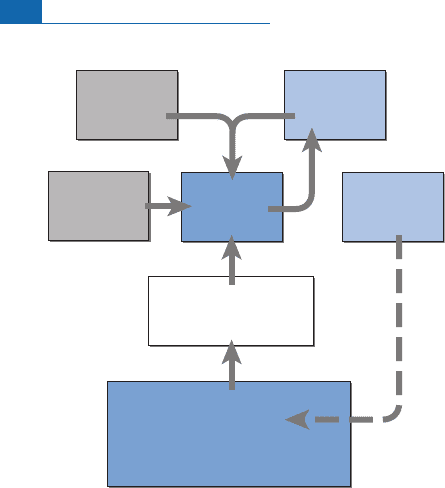
These isotopic compositions have been studied and are found to have varied in the past.
The curve of variation of strontium in the course of the Cenozoic has been drawn up with
particularcare(Figure 7.43).
Itshowsthatthe
87
Sr/
86
Sr ratiowaslower65 Maagothanitistodayandremainedroughly
constant from 65 Ma to 40 Ma, from which date it began to rise, at varying rates, up to the
p resent-day value.Whydidthesevariationsoccur?
Returningto our funda mental mas sbalanc e equation, we mustconcludethatthegrowth
in the ocean’s
87
Sr/
86
Sr ratio since 40 Ma can be attributed to a variation in the relative
inputoferosion from thelandmassesor the input fromthe mantle, orboth. Initially, a ¢erce
con£i ct opposed proponents of the growth of continental input with mantle input supp o-
sedly remaining constant an d their adversaries who thought that it was the mantle input
that had varied along with the intensity of erosion. For the former, the predominant phe-
nomenon wasthe upliftofthe Himalayas after India collided with Asia 40 Maago (Raymo
and Ruddiman,1992). For thelatter, the essentialvariationwas in the activityofmid-ocean
ridges in the form of the hydrothermal circu lation occurring there (Berner et al., 1983).
Now, it was oncethoughtthatthe total activityofthe mid-ocean ridges hadvaried overgeo-
logical time and in particular had d eclined si nce 40 Ma ago.We no longer think this.The
ideatodayis thatboth changes are concomitant.The in creasederosionbecause ofthe uplift
of the Himalayas is consistent with reduced input fro m the mantle, which der ives mostly
from erosion of subduction zone volcanoes. Such erosion has been partially slowed by the
disappearance of a signi¢cant source wh ich was swallowed up in the Himalayan collision.
All in all, then, it is the formation of the H imalayas that explains the
87
Sr/
86
Sr curve as
Silicates Carbonates
Sea
water
Marine
carbonates
Mid-ocean
ridge
hydrothermalism
Continental
rivers
Mantle
Volcanic
islands
Figure 7.42 The determining factors of the isotope composition of strontium in sea water. The strontium
in the ocean comes from alteration of the continents and volcanic arcs. Hydrothermal circulation along
the ridges also injects strontium into sea water. Limestones reflect the isotopic composition of the ocean
at the time they formed. They are recycled either by erosion or by inclusion in the mantle.
424 Stable isotope geochemistry

suggested by the former Columbia team (Raymo and Ruddiman,1992) and John Edmond
(1992) from MITindependently.
Regardlessofany causal explanations, the curve is nowadaysuse d to dateCenozoiclime-
stones.T his is known as Sr stratigraphic dating.The idea is straightforward en ough. Since
the curve is identical for all the oceans, it is an absolute m arker. As the var iation in the
87
Sr/
86
Sr curve is all one way, the measurement of an
87
Sr/
86
Sr ratio for any limestone can
be used to determine its age from the curve. As can be seen, this clock is e¡ective from 0 to
40 Ma, but barelybeyond that as the curve £ attens out.The precision achieved for an age is
1Ma.This is auseful coupling with micropaleontologicaltechniques.
But,ofcourse, whateveryonewantstoknowiswhy the
87
Sr/
86
Sr ratio curvei n limestones
is identical whichever the ocean? The answer is thatthe residence time of Sr in the oc ean is
very much greater than its mixing time and so it has time to homogenize on a global scale.
Thiswillbe explained inthenextchapter.
The second question relates to cli mate. As it is observed that d
18
O increased through-
out the Cen ozoic, corresponding to a general cooling, what relation is there between
tectonic activity and climate? This is a fundamental question to which there is as yet no
clear answer.
Exercise
There are two inputs to the isotope composition of continental rivers: one from silicates and one
from carbonates, in the proportions of 75% from carbonates and 25% from silicates, with average
isotope ratios of (
87
Sr/
86
Sr)
silicates
¼0.708forcarbonatesand(
87
Sr/
86
Sr)
limestone
¼0.724 for
10 20 30 40 50 60 70
Age (Ma)
0.7080
0.7085
0.7090
87
Sr/
86
Sr
G (t)/G (o)
0,9
1,0
1,1
1,2
1,3
1,4
1,5
Isotopic composition
of Sr
Figure 7.43 Curve of evolution of the
87
Sr/
86
Sr ratio in sea water in Tertiary times (Cenozoic).
425 The Construction of a global geodynamic system

silicates. Suppose that carbonate recycling falls to 70%. How much will the Sr content of sea
water vary assuming that the Sr content of rivers remains the same (which is unrealistic, of
course)?
Answer
In the current situation, the Sr isotope ratio of rivers is 0.712 with 75% carbonate and 25%
silicate. Recycled limestone has a Sr isotope composition of about 0.708 while that of silicates
is 0.724. The composition for rivers with the new proportions becomes 0.7128, which gives a
value of 0.709 52 for sea water. The recycling of limestone is clearly an important parameter,
then.
Exercise
Assuming the isotope different compositions and inputs remain constant and the flow from
volcanic sources remains the same, by how much does the Sr flow from rivers have to vary to
change the ocean values from 0.708 to 0.709?
Answer
The calculation is the same as before:
R
R
¼
x
ð1
x
Þ
x
:
Therefore
F
/
F
¼þ0.49. So the flow from rivers must increase by 50%.
7.8.2 Isotopic variations of neodymium in the course
of glacial–interglacial cycles
As with Sr, the isotopic variations of Nd are related to long -period radioactivity.When
isotopicvariations are measured in Quaternarysedimentarycores, these variations canbe
attributed to di¡erences in origin alone.The in situ decay of
147
Sm in the core has virtually
no in£uence.T he fundamental di¡e rencebetween thebehaviorof Srand of Ndi n the oc ean
is that S r, having a long residenc e time (1or 2 Ma), is isotopicallyhomogeneous on the scale
of the world’s oceans whereas N d, having a shorter residence time (500^2000 years),
varies isotopically between oceans and even within oceans. For example, the "
Nd
value today averages 12 for the Atlantic Ocean, 3 for the Paci¢c, and 7 for the Indian
Ocean.These vari ations are interpreted by admitting that the Nd of sea water is a mixture
between avolcanic source coming from subdu ction zones (" 0toþ6) and a continental
source (" ^12 2).T he "
Nd
valuevaries depen dingon the degree ofvol canic activity inthe
region relativeto continentalinput (see Goldstein andHemming,2003).
Study of a Quaternary core from the Indian Ocean, south ofthe H imalayas, has allowed
theParislaboratory(Gourlanetal.,2007)tohighlightaninterestingphenomenon.The
sedimentar y coreis mostlycarbonated (more than 70% carbon ate). Byappropriate ch emi-
cal treatment, it is possible to extractthe Nd of ancient sea water trapped in the small coat-
ings of Mn surrounding foraminifers. Isotopic analysis of the Nd shows that "
Nd
varies
from 7.5 to 10.5 and that the variations follow the p attern of
18
O/
16
O £uctuation
426 Stable isotope geochemistry
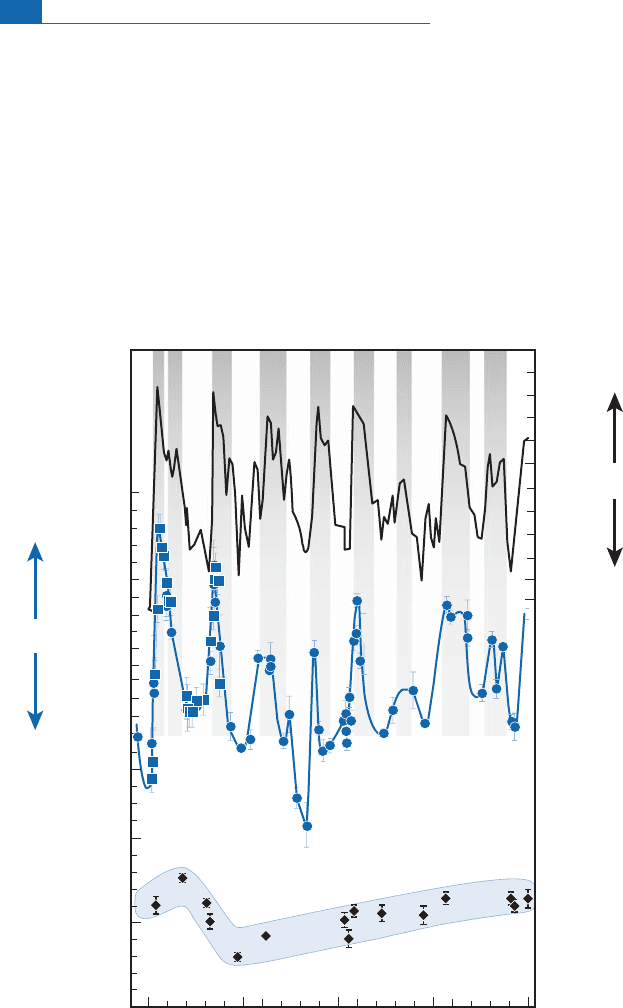
correspondingtotheglacial^interglacialpattern.Thereisan excellent(inverse)correlation
between d
18
Oand"
Nd
(Figure7.4 4).
Southofthe Bayof Bengal,th e m ixture ofout£ow from Indonesia and the input from the
Rivers Ganga^Brahmaputra(butalsothe IrrawaddyandtheSalween rivers)homogenizes
thevaluesofseawaterofa bout " 6 1.
So we can suppose that in the Bay of Bengal the £uctuation during glacial^interglacial
alternation corresponds to the £uctuation in the impact from the Ganga^Brah maputra
Rivers fro m the Himalayas. Those variations are linked with variations in i ntensity of the
–10
–9
–8
–7
0
–1
–2
Island
arc
Himala y a
–13
0 200 400 600 800
–12
–11
ε
Nd
SEA W ATER
DETRIT AL
δ
18
O
Interglacial
Glacial
AGE (ka)
Figure 7.44 Variation in the isotopic composition of neodymium in sea water expressed as "
Nd
in a
predominantly calcareous marine sedimentary core from the Ninety East Ridge in the Indian Ocean,
representing the last 800 ka. Top: the curve of d
18
O variations allowing comparison of climatic
fluctuations. Bottom: isotopic composition of the detrital fraction. (a) Oxygen isotopes compared
with "
Nd
variations. (b) Enlargement before 2 Ma. (c) Oxygen-neodymium maxima and minima
correlations.
427 The Construction of a global geodynamic system

monsoon and the existence of large glaciers during glacial periods in the high Himalayas.
Monsoons are weakerdur ing glacial times and glaciers accumulate snow and then stop (or
stronglyreduce)the river runo¡.
Exercise
Calculate the relative input of the Ganges–Brahmaputra (GB) Rivers between interglacial and
glacial if we suppose that "
GB
ND
¼12 and "
ocean
Nd
¼6. The measured ratios of concentration
are "
Nd
¼10 during interglacials and "
Nd
¼7.5 during glacials, the concentration of Nd in
river and ocean staying the same during all periods.
Answer
We applied the mixing formula. Notating concentration as
C
Nd
and the masses as
m
, we have:
"
measured
Nd
¼ "
GB
Nd
x
þ "
ocean
Nd
1
x
ðÞ
x
¼
mass of fresh water
C
river
Nd
mass ocean
C
ocean
Nd
þ mass of fresh water
C
river
Nd
:
With a little manipulation
m
river
m
ocean
¼
C
ocean
Nd
C
river
Nd
1
x
1
1
:
So for the ratios between interglacial (i) and glacial (g):
m
i
river
m
g
river
¼
x
1
g
1
x
1
i
1
!
¼
3
0:5
¼ 6:
The river £ux from the Himalayas was 6 times higher in interglacial than in glacial
times.
This is a simple example in a work in progress in author’s laboratory to illustrate the
p owerof investigation ofcombining Oand Ndisotopes.
7.9 Sulfur, carbon, and nitrogen isotopes and
biological fractionation
We give two examples of how stable isotope geochemistry can be used in various types
ofstudy.
7.9.1 A few ideas on sulfur isotope fractionation
When we examine the
34
S/
32
S composition of naturally occurring sulfur isotopes as a
function of their geological characteristics, several features stand out. A ll sul¢des asso-
ciated with basic or ultrabasic rocks have extremely constant compositions close to
428 Stable isotope geochemistry
